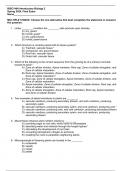lOMoARcPSD|25701531
BISC1404 Introductory Biology 2
Spring 2024, Final Exam
Name___________________________________
MULTIPLE CHOICE. Choose the one alternative that best completes the statement or answers
the question.
1. Under ________ condition the ________ cells promote open stomata.
A) dry, guard
B) humid, guard *
C) dry, parenchyma
D) humid, parenchyma
2. Which structure is correctly paired with its tissue system?
A) Tracheid, vascular tissue *
B) Companion cell, ground tissue
C) Root hair, vascular tissue
D) Guard cell, vascular tissue
3. Which of the following is the correct sequence from the growing tip of a primary root back
toward its base?
A) Zone of cellular division, Apical meristem, Root cap, Zone of cellular elongation, and
Zone of cellular maturation
B) Root cap, Apical meristem, Zone of cellular division, Zone of cellular elongation, and
Zone of cellular maturation *
C) Root cap, Zone of cellular elongation, Apical meristem, Zone of cellular division, and
Zone of cellular maturation
D) Apical meristem, Zone of cellular elongation, Zone of cellular division, Root cap, and
Zone of cellular maturation
E) Zone of cellular elongation, Zone of cellular maturation, Root cap, Apical meristem,
and Zone of cellular division
4. Two examples of lateral meristems in plants are ________.
A) vascular cambium, producing secondary phloem, and cork cambium, producing
secondary xylem
B) vascular cambium, producing secondary xylem, and cork cambium, producing cork *
C) vascular cambium, producing cork, and cork cambium, producing secondary phloem
D) vascular cambium, producing secondary xylem, and cork cambium, producing
secondary phloem
5. Mycorrhizae enhance plant nutrition mainly by ________.
A) providing sugar to root cells, which have no chloroplasts
B) absorbing water and minerals through the fungal hyphae *
C) stimulating the development of root hairs
D) converting atmospheric nitrogen to ammonia
E) enabling the roots to parasitize neighboring plants
6. Microsporangia in flowering plants are located in the ________.
A) receptacle
B) sepals
C) carpel
D) petals
, lOMoARcPSD|25701531
E) stamen *
7. When the mammalian brain compares the actual temperature of the body to the preferred
temperature of the body, which component of a homeostatic control system is being used?
A) Blood vessels
B) Effector
C) Integrator *
D) Sensor
E) Sweat glands
8. The thin horizontal arrows in the figure show that the ________.
A) goose's legs get progressively warmer as the blood moves away from the abdomen
toward the feet
B) warmer arterial blood can bypass the legs as needed, when the legs are too cold to
function well
C) warmer venous blood transfers heat to the cooler arterial blood
D) arterial blood is always cooler in the abdomen, compared to the temperature of the
venous blood in the feet of the goose
E) warmer arterial blood transfers heat to the cooler venous blood *
9. The membrane potential in which there is no net movement of the ion across the membrane is
called the ________.
A) equilibrium potential *
B) action potential
C) inhibitory postsynaptic potential
D) threshold potential
E) graded potential
10. Depolarization of a membrane can be induced by ________.
A) decreasing its membrane's permeability to Cl−
B) decreasing its membrane's permeability to H+
C) increasing its membrane's permeability to Na+ *
D) increasing its membrane's permeability to K+
E) increasing its membrane's permeability to Ca++
, lOMoARcPSD|25701531
11. What is the only type of chemical signal that is released from a neuron and diffuses in blood to
distant cells?
A) Autocrine signals
B) Paracrine signals
C) Neurohormones *
D) Neurotransmitters
E) Hormones
12. A cell with membrane-bound proteins that selectively bind a specific hormone is called the
________ for that hormone.
A) regulatory cell
B) plasma cell
C) target cell *
D) secretory cell
E) endocrine cell
13. After drinking alcoholic beverages, increased urine excretion is the result of ________.
A) inhibited secretion of antidiuretic hormone (ADH) *
B) the osmoregulator cells of the brain increasing their activity
C) increased blood pressure
D) increased reabsorption of water in the proximal tubule
E) increased aldosterone production
14. After ingestion by humans, which macromolecule(s) begin(s) chemical digestion by enzymes in
the mouth?
I. Protein
II. Fat
III. Nucleic acids
IV. Carbohydrates
A) Only IV
B) Only II and IV *
C) Only I
D) Only I and IV
E) Only I, II, and III
15. In which location would you expect the oxygen concentration to be the lowest?
A) Within tissues *
B) The lungs
C) The heart
D) The environment
E) The blood
16. In mammals, gas exchange between the atmosphere and the pulmonary blood occurs in the
________.
A) larynx
B) bronchi
C) trachea
D) bronchioles
E) alveoli*




